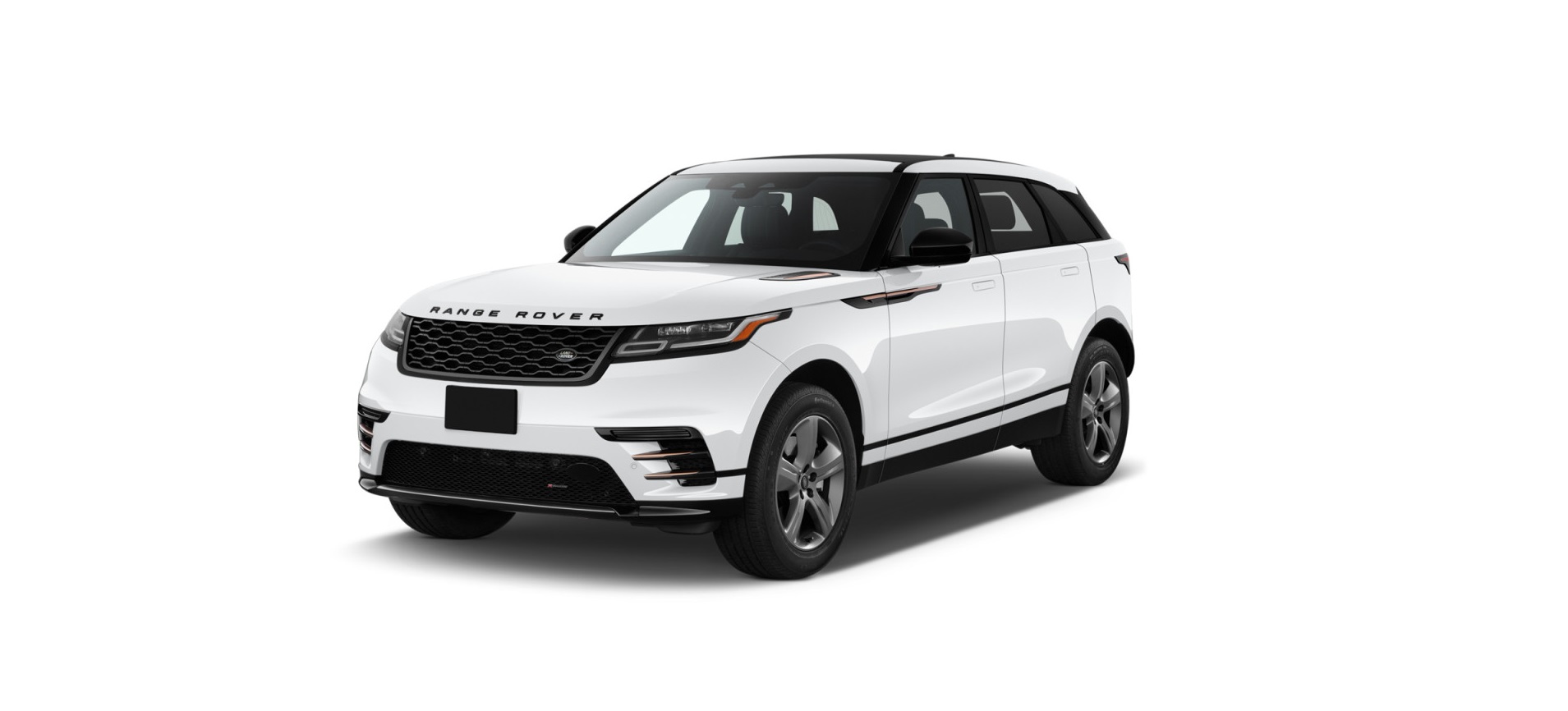2022 Land Rover Range Rover Velar Adaptive Cruise Control
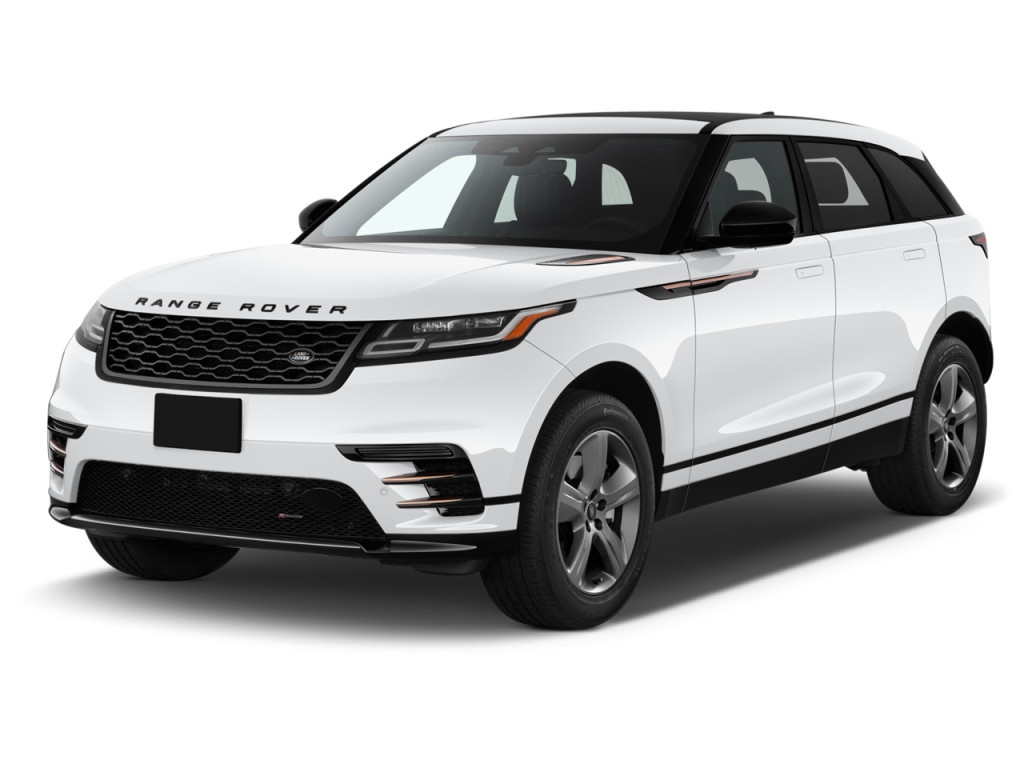
ADAPTIVE CRUISE CONTROL SAFETY
Make sure the following warnings have been read and fully understood before using adaptive cruise control or any of its features. Failure to use adaptive cruise control or any of its features safely could result in an accident, leading to serious injury or death.
Adaptive cruise control is not a substitute for driving safely, with due care and attention. Staying alert, driving safely, and being in control of the vehicle at all times is the responsibility of the driver.
Adaptive cruise control may not function properly under all weather and road conditions. Do not use adaptive cruise control in poor visibility, specifically fog, heavy rain, spray, or snow. Using adaptive cruise control in these conditions increases the risk of a loss of control of the vehicle.
Adaptive cruise control does not react to pedestrians, objects in the roadway, or oncoming vehicles in the same lane. Additionally, the system may not react to stationary or slow-moving vehicles, e.g., cyclists and motorcyclists.
Adaptive cruise control uses a radar sensor and camera to monitor the area in front of the vehicle. The radar sensor is mounted on the front of the vehicle. The camera is mounted on the rear of the rear-view mirror. Keep these areas of the vehicle clean and free from obstructions, e.g., stickers, debris, mud, snow, or ice. Failure to do so may result in the system failing to identify objects ahead. The driver should remain alert and intervene, if necessary when adaptive cruise control is in operation.
The adaptive cruise control system may operate unexpectedly in certain conditions. For example:
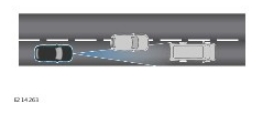
When driving on a different line from the vehicle in front.
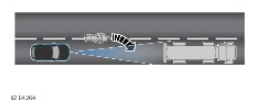
When a vehicle edges into the same lane as the vehicle being driven. The vehicle is only detected once it has moved fully into the same lane.
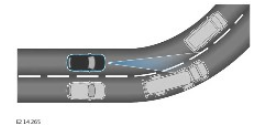
When entering or exiting a bend. Vehicles in front may not be detected.
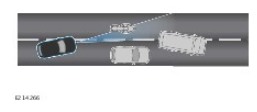
When moving around a stationary vehicle. The detection beam may become uncertain as to which vehicle should be followed.
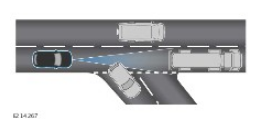
When the vehicle in front turns out of the same lane as the vehicle being driven. The detection beam may become uncertain as to which vehicle should be followed.
ADAPTIVE CRUISE CONTROL OVERVIEW
Make sure the relevant safety warnings have been read and understood before driving the vehicle. See ADAPTIVE CRUISE CONTROL SAFETY. Adaptive cruise control allows the driver to set a cruising speed for the vehicle. The vehicle’s speed is automatically reduced if a slower-moving vehicle is detected in the lane ahead. The system then maintains a constant gap to the vehicle ahead. If the system detects that the slower-moving vehicle is no longer present, it automatically raises the vehicle’s speed back to the set speed. In some scenarios, adaptive cruise control also brings the vehicle to a standstill, if required.
The adaptive cruise control system illuminates the brake lights when it applies the brakes. Noise may also be heard.
Adaptive cruise control comprises a number of different sub-features in order to operate effectively, including:
- Follow mode. See FOLLOW MODE.
- Queue assist. See QUEUE ASSIST.
- Stop and go. See STOP AND GO.
- Steering assist. See STEERING ASSIST.
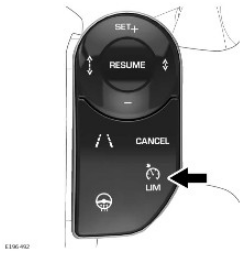
- Adaptive cruise control is not available when the speed limiter is in operation.
- When the vehicle is first switched on, the vehicle reverts to whichever system was used previously.
- Press the LIM button on the steering wheel controls to switch between the speed limiter and adaptive cruise control.
- The instrument panel displays a message if a fault occurs in the adaptive cruise control system, or in any of its sub-features.
- If this occurs, adaptive cruise control does not operate. Consult a retailer/authorized repairer at the earliest opportunity.
ADAPTIVE CRUISE CONTROL
Make sure the relevant safety warnings have been read and understood before driving the vehicle. See ADAPTIVE CRUISE CONTROL SAFETY.
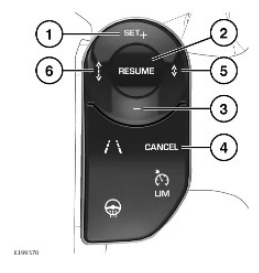
- SET+.
- RESUME.
- –.
- CANCEL.
- <->: Follow mode gap decrease.
- <—>: Follow mode gap increase.
- Press the SET+ button to set the desired cruising speed.
- The vehicle’s cruising speed is set at the speed it was traveling when the button was pressed.
- Fully release the accelerator pedal when a cruising speed is set.
- Press the CANCEL button to deactivate adaptive cruise control.
- Press the RESUME button to reactivate the adaptive cruise control.
The RESUME button should only be pressed if the driver is aware of the set cruising speed and intends to return to it. Pressing the RESUME button when not aware of the set cruising speed may lead to a loss of control of the vehicle.
- The instrument panel displays a white information lamp to inform the driver that adaptive cruise control is engaged.
- The instrument panel information lamp illuminates green when adaptive cruise control is active.
- The LIM icon on the steering wheel controls also illuminates to confirm the adaptive cruise control status.
- When adaptive cruise control is operating, it monitors the area in front of the vehicle to identify any vehicles which are in its path.
- The vehicle’s cruising speed is controlled accordingly. See FOLLOW MODE.
- Adaptive cruise control may also react to stationary vehicles that it previously recognized as traveling in the same direction. See QUEUE ASSIST.
ADAPTIVE CRUISE CONTROL LIMITATIONS
The sensors used by the adaptive cruise control system may become impaired by mud, rain, frost, ice, snow, road spray, etc. The adaptive cruise control system’s ability to detect a vehicle in the driver’s blind spot may subsequently be affected and may give false indications.
Adaptive cruise control:
- Should only be used when conditions are favorable. For example, on major roads with traffic moving in lanes.
- Should not be used during abrupt or sharp turns. For example, traffic medians, junctions, areas with many parked vehicles, or areas shared with pedestrians.
- Performance and operation can be affected by the use of non-recommended tires. Non-recommended tires may have a different circumference to those recommended for the vehicle.
- Performance may be inhibited if accumulations of dirt, snow, or ice build up on the radar sensor or camera. Fitting a protector or metalized badges to the front of the vehicle may also affect adaptive cruise control operation.
The instrument panel displays Driver intervention, followed by the Radar sensor blocked if a sensor’s operation becomes affected by an obstruction. Clearing the obstruction from the sensor allows the system to return to normal operation. Operation is resumed automatically once the obstruction is removed. The instrument panel may also display a Radar sensor blocked temporarily if the radar sensors or camera’s vision is disrupted for a long period. For example, in poor weather conditions, when traveling through a tunnel, or in complex traffic situations. The instrument panel may also display a Radar sensor blocked when traveling on open roads with few objects for the radar to detect.
Adaptive cruise control does not operate if:
- Reverse (R) or Park (P) is selected.
- The speed limiter is in operation.
Adaptive cruise control automatically deactivates, but does not clear its memory, when:
- The CANCEL button on the steering wheel controls is pressed. See ADAPTIVE CRUISE CONTROL.
- The brake pedal is pressed.
- The Anti-lock Braking System (ABS) requests a cruise control cancellation.
- The Electric Parking Brake (EPB) is applied.
Adaptive cruise control automatically deactivates, and its memory is cleared, when:
- All Terrain Progress Control (ATPC) is selected.
- The vehicle is switched off.
- A fault occurs in the adaptive cruise control system.
ADAPTIVE CRUISE CONTROL DRIVER INTERVENTION
Make sure the relevant safety warnings have been read and understood before driving the vehicle. See ADAPTIVE CRUISE CONTROL SAFETY. The amount of braking applied by the adaptive cruise control system is limited. The system sounds an audible warning and the instrument panel displays a message if the system’s braking limits are reached. The driver should intervene immediately and apply a higher level of braking force using the brake pedal. Adaptive cruise control cancels when the brake pedal is pressed, or if the vehicle becomes stationary. Press the RES switch on the steering wheel controls to resume adaptive cruise control operation. See ADAPTIVE CRUISE CONTROL. Pressing the accelerator pedal inhibits adaptive cruise control braking. The following mode amber warning lamp extinguishes to confirm the system has been overridden. See FOLLOW MODE (GREEN). Adaptive cruise control operation resumes when the accelerator pedal is released.
FOLLOW MODE
Make sure the relevant safety warnings have been read and understood before driving the vehicle. See ADAPTIVE CRUISE CONTROL SAFETY. When adaptive cruise control identifies a slower-moving vehicle in the lane ahead, it automatically enters follow mode. Adaptive cruise control adjusts the vehicle’s speed by controlling acceleration and braking to maintain a set gap to the vehicle ahead.
When in follow mode, the vehicle may not decelerate automatically to a stop, nor does the vehicle always decelerate quickly enough to avoid a collision. Always maintain a safe gap to the vehicle ahead to reduce the risk of an accident.

The instrument panel displays an amber warning lamp to confirm that follow mode is active. See FOLLOW MODE (GREEN).
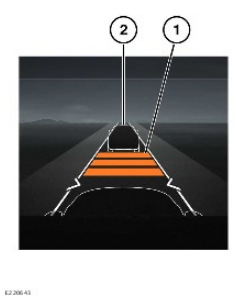
- Follow the mode gap setting.
- Targeted vehicle.
The instrument panel may also display the following mode gap setting and a representation of the targeted vehicle. If the turn signals are used, follow mode may reduce the gap to the vehicle ahead in anticipation of a maneuver. If a maneuver is not carried out, follow mode restores the previous gap setting after a few seconds.
Follow mode may not reduce the gap to the vehicle ahead if it is deemed inappropriate. For example, the vehicle ahead is already too close, or the maneuver has already been completed. The following mode gap to the vehicle ahead can be adjusted. See CHANGING THE FOLLOW MODE GAP.
SWITCHING FOLLOW MODE OFF
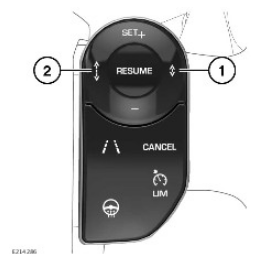
- <->: Follow mode gap decrease.
- <—>: Follow mode gap increase.
Switching follows mode off and allows the driver to take control of the vehicle’s speed. When follow mode is switched off, the adaptive cruise control system does not provide any vehicle braking. Vehicle braking must be applied by the driver.
Press and hold the following mode gap decrease button (1) on the steering wheel controls to switch follow mode off. The follow-mode off-white warning lamp illuminates to confirm the feature has been switched off.
If the follow mode gap decrease button (1) is held for too long, the request to switch follow mode off is ignored. Press and release either the decrease (1) or increase (2) button on the steering wheel controls to switch follow mode back on. If adaptive cruise control is active and tracking a vehicle, the follow-mode off-white warning lamp extinguishes. The following mode amber warning lamp illuminates to confirm the feature has been switched back on. The previous follow mode gap setting is resumed.
Follow mode resumes if:
- The vehicle is switched off.
- Adaptive cruise control is not used for a long period of time.
CHANGING THE FOLLOW MODE GAP
Make sure the relevant safety warnings have been read and understood before driving the vehicle. See ADAPTIVE CRUISE CONTROL SAFETY.
The driver is responsible for selecting options appropriate for the driving conditions. Always drive with due care and attention. Driving without due care and attention greatly increases the risk of an accident. Follow mode has four different gap settings. Gap 3 is the default gap setting when the vehicle is switched on.
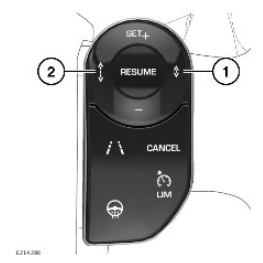
- <->: Follow mode gap decrease.
- <—>: Follow mode gap increase.
- To decrease the follow mode gap, press the decrease button (1) on the steering wheel. To increase the follow mode gap, press the increase button (2) on the steering wheel.
- The instrument panel displays a vehicle image with a number of bars when the following mode gap is adjusted. The number of bars displayed in front of the vehicle image reflects the following mode gap setting.
FOLLOW MODE LIMITATIONS
Follow mode maintains a constant gap to the vehicle ahead until:
- The vehicle ahead accelerates to a speed above the adaptive cruise control set speed. If this occurs, the vehicle stops accelerating when the set speed is reached.
- The vehicle ahead moves out of the lane or out of view. If this occurs, the vehicle accelerates to the adaptive cruise control set speed.
QUEUE ASSIST
- Make sure the relevant safety warnings have been read and understood before driving the vehicle. See ADAPTIVE CRUISE CONTROL SAFETY.
- Queue assist enhances the adaptive cruise control follow mode feature. See FOLLOW MODE.
- Queue assist operates at lower speeds than follow mode, allowing the feature to be used in slow-moving lines of traffic.
- When the targeted vehicle slows to a standstill, queue assist brings the vehicle to a standstill.
- When the targeted vehicle moves off, briefly press the accelerator pedal, if safe to do so.
- Queue assist now maintains a constant gap to the vehicle ahead.
Queue assist may not recognize a stationary vehicle or object. To avoid an impact, it is important that the driver is prepared to press the brake pedal when approaching stationary vehicles or objects, if necessary.
If the vehicle is stationary, queue assist also applies the Electric Parking Brake (EPB), including when:
- Adaptive cruise control is canceled by the driver.
- The driver’s seat belt is unbuckled.
- The driver’s door is opened.
Adaptive cruise control deactivates when the EPB is applied.
STOP AND GO
- Make sure the relevant safety warnings have been read and understood before driving the vehicle. See ADAPTIVE CRUISE CONTROL SAFETY.
- In certain circumstances, adaptive cruise control is able to follow a targeted vehicle down to a standstill. See QUEUE ASSIST.
- The stop-and-go feature automatically accelerates the vehicle away from a standstill, if the targeted vehicle pulls away within a few seconds.
- A short press of the accelerator pedal is required if the targeted vehicle is stationary for longer than a few seconds.
- A short press of the accelerator pedal is also required if not all system requirements are met.
The instrument panel displays a warning message if adaptive cruise control detects an object in its immediate path when accelerating away from a standstill. Adaptive cruise control does not apply the brakes. Braking in order to avoid an impact remains the responsibility of the driver.
STEERING ASSIST
Make sure the relevant safety warnings have been read and understood before driving the vehicle. See ADAPTIVE CRUISE CONTROL SAFETY. Steering assist helps the driver keep the vehicle in the center of the lane in which it is traveling. The system does this by making steering adjustments.
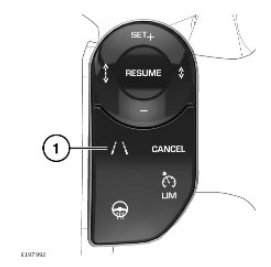
Press the button on the steering wheel (1) to activate the steering assist. Press the button a second time to switch the feature off. When active, the instrument panel displays the steering assist system status.
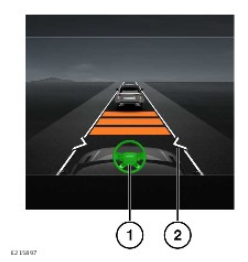
- Steering assist active.
- Tracked lane borders.
If the driver’s hands are removed from the steering wheel, the vehicle presents a series of visual and audible warnings. Steering assistance is stopped if the warnings are ignored. Under normal circumstances, if the driver uses the turn signals steering assistance stops in the direction indicated.
Steering assist is a driving aid only and not a substitute for driving safely, with due care and attention. Driving without due care and attention greatly increases the risk of an accident.
Steering assist does not steer the vehicle autonomously. The driver must remain in full control of the vehicle at all times. Failure to remain in full control of the vehicle greatly increases the risk of an accident.
Do not use steering assist if a trailer is connected to the vehicle. The trailer may cause the steering assist feature to make incorrect judgments, increasing the risk of an accident.
STEERING ASSIST LIMITATIONS
Steering assist does not operate if:
- Adaptive cruise control is not active.
- The vehicle is traveling at speeds higher than 124mph (200 km/h).
- The driver’s hands are removed from the steering wheel.
- The camera is obscured, e.g., by stickers, mud, or other debris.
- The road lanes are too wide or too narrow.
- The road lane boundaries in which the vehicle is traveling are not clear and visible to the camera.
- The corner through which the vehicle is traveling is too tight.
- There is a fault in the system.
Steering assist operates with a reduced level of performance and accuracy if:
- Operation of the camera is impaired due to severe weather conditions, e.g., heavy rain, fog, snow, or ice.
- The operation of the camera is impaired due to extreme sunlight.
- Road markings, or in some cases a road edge, are not recognized on both sides of the lane in which the vehicle is traveling.
- Operation of the driver monitoring system is impaired, e.g., when thick gloves are worn.
- There is excessive liquid on the steering wheel.
- There is unintentional contact with the steering wheel.
- Steering aids or prosthetics are used.
ADAPTIVE CRUISE CONTROL TYPE APPROVAL NUMBERS
This device complies with part 15 of the FCC rules. Operation is subject to the following two conditions:
- This device may not cause harmful interference, and
- this device must accept any interference received, including interference that may cause undesired operation.
This device complies with Industry Canada Standard IC – RSS-210. Operation is subject to the following two conditions:
- This device may not cause interference, and
- this device must accept any interference, including interference that may cause undesired operation of the device.
Changes or modifications, not expressly approved by the manufacturer, could void the user’s authority to use the equipment.
The adaptive cruise control Radio Frequency approval numbers for the USA and Canada are:
| USA FCC ID: | L2C0038TR |
| Canada IC: | 3432A-0038TR |
